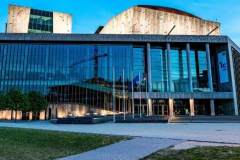Italian Concertos
December 2025 | ||||||
|---|---|---|---|---|---|---|
Mo | Tu | We | Th | Fr | Sa | Su |
For most people, a single trumpet is all it takes to put them in a cheerful mood. Two trumpets at the same time? Now that’s a party! Gábor Boldoczki and Sergei Nakariakov arrive in mid-December bearing an ideally timed sonic gift in advance of the lights of the upcoming Christmas holiday. The evening will brim with the brilliance of the masterpieces of the Italian Baroque concerto repertoire. These include works by Vivaldi and Alessandro Marcello, which are sometimes played on two trumpets or even on two flugelhorns, in the same fashion that we will hear the two artists play the music of Geminiani, Locatelli, and Corelli, accompanied by the Gabetta Consort performing under the leadership of Andrés Gabetta. The internationally renowned Argentine/French violin ensemble has already enjoyed great success on its previous visits to Müpa Budapest, as have the two trumpet wizards. The latter pair took the stage of the Béla Bartók National Concert Hall together in 2023 to perform Fazil Say’s Double Concerto, which was written specifically for them.
Program and cast
trumpet, flugelhorn:Gábor Boldoczki, Sergei Nakariakov
Gabetta Consort (artistic director and concertmaster: Andrés Gabetta)
Program
Corelli:
Concerto Grosso in G minor (‘Christmas Concerto’), Op. 6, No. 8
Vivaldi:
Concert in C minor for Cello, Strings and Basso Continuo, RV 401 – transcribed for flugelhorn
Locatelli:
Concerto Grosso in C minor, Op. 1, No. 11
Vivaldi:
Concerto in C major for Two Flutes, Strings and Basso Continuo, RV 533 – transcribed for two trumpets
Geminiani:
Concerto Grosso in D minor, (‘La Follia’) – after Corelli, H. 143
A. Marcello:
Oboe Concerto in C minor – transcribed for trumpet
Vivaldi:
Violin Concerto in D major (‘Il Grosso Mogul’), RV 208
Vivaldi:
Concerto in G minor for Two Cellos, Strings and Basso Continuo, RV 531 – transcribed for flugelhorn
Palace of Arts Müpa Budapest
When Müpa Budapest, Hungary and its capital's new cultural hub, opened in 2005, it was built to represent more than 100 years of Hungarian cultural history. As a conglomeration of cultural venues, the building has no precedent in 20th century Hungarian architecture and has no peers in the whole of Central Europe.
The creators of this ambitious project, the Trigránit Development Corporation, prime contractor Arcadom Construction and the Zoboki, Demeter and Partners Architectural Office, were driven by the desire to create a new European cultural citadel as part of the new Millennium City Centre complex along the UNESCO World Heritage-listed Danube waterfront. The result is a facility whose construction quality, appearance, functionality and 21st century technological infrastructure makes it ideally suited to productions of the highest standard. The building is also highly versatile and equipped to host performances of any genre and almost any scale.

 EN
EN DE
DE IT
IT FR
FR ES
ES RU
RU JP
JP RO
RO
 Seating plan
Seating plan 
